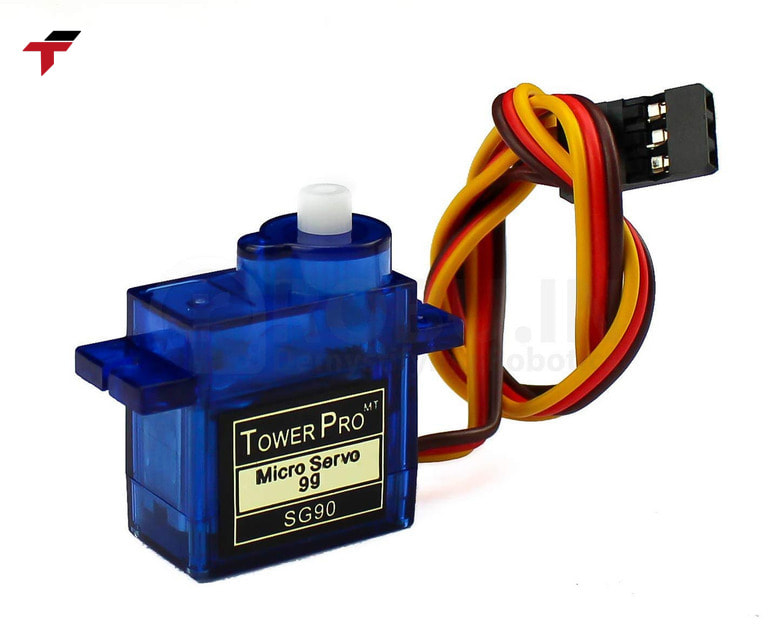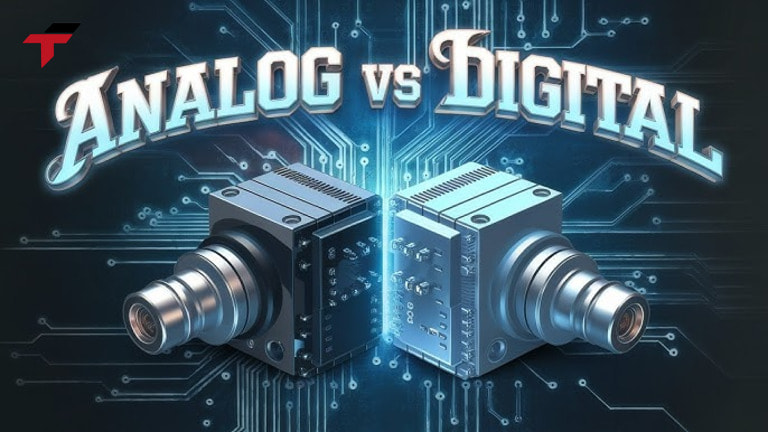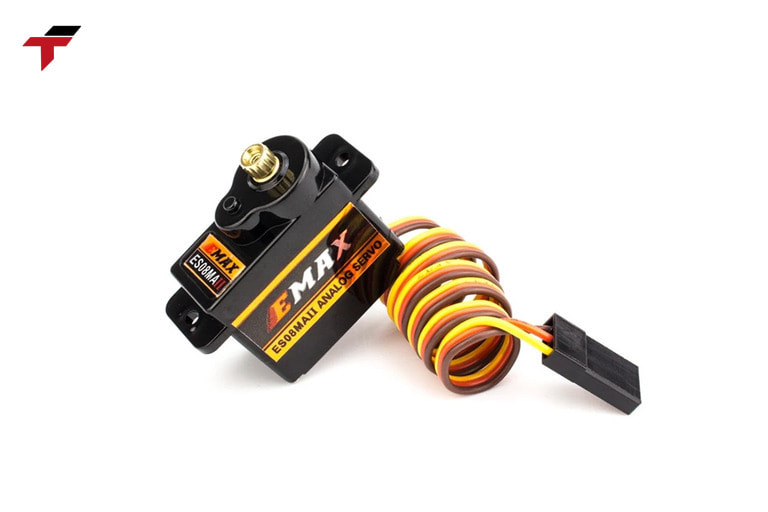In automation and robotics, servo motors are essential for controlling motion with precision and reliability. Among the various types, Analog Servo Motors remain a practical solution for basic positioning tasks and cost-effective control systems. In this article, Flextech explains how analog servos work, their structure, benefits, limitations, and when they are the right choice for your application.
What is Analog Servo?
An Analog Servo Motor is a motion control device that operates using analog signals, typically PWM (Pulse Width Modulation) or voltage control (0–5V). When a control pulse is received, the internal circuit compares the signal with the feedback position from the potentiometer and drives the DC motor until the target position is reached.
This closed-loop control mechanism allows for precise angular movement, making analog servos ideal for simple automation systems, RC models, and training robots.
Each analog servo contains three main parts:
- Mini DC Motor – Converts electrical energy into mechanical motion.
- Potentiometer – Provides feedback on the current position of the output shaft.
- Analog Control Circuit – Compares input and feedback signals to adjust motor power accordingly.
Because they operate without a microprocessor, analog servos are simpler, lighter, and more affordable, but offer less signal processing capability compared to digital servos.
How many parts does an Analog Servo consist of?
The internal structure of an analog servo is compact yet efficient, consisting of three main components working in a feedback loop:
- DC Motor (Actuator): The small brushed DC motor produces torque to move the output shaft. It operates in short bursts depending on the incoming PWM pulse width.
- Potentiometer (Position Sensor): Connected directly to the output shaft, this component detects angular changes. When the servo rotates, the potentiometer changes resistance, sending feedback to the control circuit.
- Analog Control Circuit (Controller): Acts as the comparator. It continuously monitors the difference between the input command signal and the actual feedback. When an error exists, the circuit adjusts current flow to the motor until both values match.
All these components are housed within a compact enclosure that can be easily installed in devices such as mini robots, mechanical arms, automatic flaps, or conveyor gate controls.

Analog Servo consist of 3 parts
What is the difference between Analog Servo and Digital Servo?
In the motion control system, both analog servo and digital servo play an important role, but are distinctly different in the way they operate and their signal processing capabilities.
Control Signals
- Analog servos use a continuous signal (such as a standard 50Hz PWM)
- Digital servos use an internal microprocessor to analyze and control the signal, allowing for faster response and more precise processing.
Accuracy & Response
- Analog servos have a slower response and are susceptible to signal noise.
- Digital servos excel in accuracy, torque, and position holding.
Programmability & Cost
- Analog servos are simple in structure, inexpensive, and easy to use – suitable for less demanding applications.
- Digital servos can customize parameters (rotation angle, speed, force feedback) through software, but are typically more expensive.
Choose analog servos if you need an economical, easy-to-assemble solution for DIY projects, educational robots, or simple systems.
Choose digital servo if the application requires high precision, fast response, large torque and detailed programming capabilities (industrial robots, automatic arms, gimbals, etc.).

Analog servo and digital servo play an important role, but are distinctly different in the way they operate
What are the advantages of Analog Servo?
With a simple structure and the ability to operate stably in many basic situations, analog servo is especially suitable for applications that do not require too high performance. Some outstanding advantages include:
- Low cost, easy to access: Analog servo is much cheaper than digital servo, thanks to its simple structure and does not use an internal microprocessor. This is an ideal choice for students, beginners in automatic control or projects that need to be implemented on a budget.
- Easy to use with basic control circuits: With common control signals (such as PWM 50Hz), analog servo can be directly connected to microcontrollers such as Arduino, Raspberry Pi, or PLCs with analog outputs without complicated configuration.
- Smooth response at low speeds: In simple movements with few sudden changes, analog servos provide smooth and stable control without the need for an intermediate processor.
- Popularity and ease of replacement: Because they are widely used in educational robots, RC models, digital toys, etc., analog servos are readily available on the market with a variety of power levels, sizes, and pin standards.
What are the disadvantages of Analog Servo?
Although analog servos have many advantages in terms of cost and simplicity, when considering performance in modern control systems – especially in industrial environments – they still have certain limitations.
Understanding these weaknesses will help you make more appropriate choices when designing or upgrading your system.
- Low accuracy: Because they do not use an internal microprocessor, analog servos respond to control signals linearly and continuously, so their ability to hold position or respond quickly to command changes is often worse than digital servos.
- Susceptible to signal interference: Due to the dependence on PWM signals or analog voltage, the system is susceptible to electromagnetic interference or line interference, leading to position deviation or slight vibration during operation.
- Weak torque and response: In tasks requiring strong force, large loads or fast response (such as industrial robots, specialized gimbals), analog servos often do not meet the requirements – easily hot, noisy or unstable operation.
- No support for advanced programming: Unlike digital servos, analog servos do not allow for customization of parameters such as delay, maximum speed, rotation angle limit.

Disadvantages of Analog Servo
What are the considerations when choosing Analog Servo for businesses?
When selecting an Analog Servo for your system, businesses should carefully evaluate both technical and environmental factors to ensure stable performance and long service life. Key considerations include:
- Torque capacity: Choose a servo with sufficient torque to move or lift the load without overloading. Add a 20–30% safety margin to prevent overheating or vibration during continuous operation. For semi-industrial or long-term use, prefer metal gear servos with higher torque strength.
- Rotation angle and response speed: Standard analog servos provide 180° rotation, suitable for positioning or basic movement. Continuous rotation (360°) models are ideal for conveyors or simple drive systems. Prioritize fast response time to ensure smooth operation in applications with frequent motion.
- Control signal compatibility: Verify the signal type supported: PWM or analog voltage (0–5V). Ensure compatibility with control devices such as PLCs, Arduino, or other analog controllers.
- Power supply requirements: Most analog servos operate at 4.8–7.4V DC. Use a stable, regulated power source. Check current draw and ensure the power supply can handle peak loads if multiple servos run simultaneously.
- Operating environment: Choose models with metal housings or higher IP ratings for dusty or high-temperature environments. Plastic gear types are suitable for educational or DIY projects; metal gear servos are better for continuous operation. Consider vibration resistance if used in packaging, conveyor, or light robotic systems.
Conclusion
Analog Servo Motors remain a practical and cost-effective solution for basic motion control needs — especially in applications where simplicity, stability, and affordability matter. While they may not deliver the same precision or high-speed feedback as digital servos, analog servos still perform excellently in educational setups, prototype systems, or small-scale automation lines.
For businesses, understanding how to choose the right model based on torque, control compatibility, and operating environment will ensure long-term performance and reliability. If your factory or project requires a servo solution that is easy to integrate, durable, and fully supported, Flextech is ready to assist — providing expert consultation and optimized servo options tailored to your specific application.


